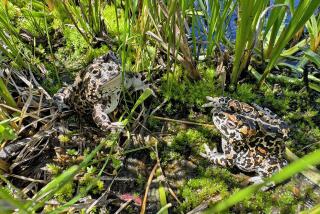Western spadefoot
- Share via
[ SPEA HAMMONDII ]
Deep in their underground burrows, spadefoot toads in the undeveloped lowlands of Southern California start inching upward through the sun-warmed soil in February or March. For weeks they may lurk beneath the surface waiting to hear the drumming of a heavy spring rain overhead. Driven by this primal cue, they surge out by the tens of thousands and head for ephemeral basins of rainwater. After one to two years of waiting for the proper combination of moisture and warmth, they are extremely thirsty, hungry -- and ready for sex. Plumping their bellies down into shallow pools where their thin skin can soak up long drafts of water, males erupt into deafening choruses that sound like hoarse snoring. Mating ends quickly because the toads must return underground before the sun rises for another long sleep.
NATURAL HISTORY
The same warm rains that bring out spadefoots also trigger massive eruptions of their favorite food -- highly nutritious, fat-laden winged termites. By eating half their weight in termites in a single night, spadefoots are guaranteed enough energy to fast for a year or more.
KEY CHARACTERISTICS
Spadefoots have two diagnostic features that separate them from other toads: a vertical, cat-like pupil and a curious little “spade” on the undersides of their hind feet, the perfect tool for digging their burrows.
More to Read
Sign up for The Wild
We’ll help you find the best places to hike, bike and run, as well as the perfect silent spots for meditation and yoga.
You may occasionally receive promotional content from the Los Angeles Times.





